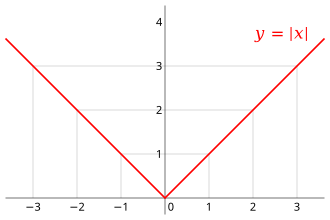Difference between revisions of "Absolute Value Functions"
Jump to navigation
Jump to search
| Line 5: | Line 5: | ||
Here are some examples of absolute value functions: | Here are some examples of absolute value functions: | ||
| − | * <math> g(x) = |5x + 5| </math>. <math> 5x + 5 | + | * <math> g(x) = |5x + 5| </math>. <math> 5x + 5 \ge 0 </math> when x ≥ -1, and 5x + 5 < 0 when x < -1. So, <math> g(x) = 5x + 5 </math> when x ≥ -1, and <math> g(x) = -5x - 5 </math> when x < -1. |
* <math> h(x) = |x^2 - 4| </math>. <math> x^2 - 4 \ge 0 </math> when -2 ≥ x or x ≥ 2. So, <math> h(x) = x^2 - 4 </math> when -2 ≥ x or x ≥ 2, and <math> h(x) = -x^2 + 4 </math> when -2 < x < 2. | * <math> h(x) = |x^2 - 4| </math>. <math> x^2 - 4 \ge 0 </math> when -2 ≥ x or x ≥ 2. So, <math> h(x) = x^2 - 4 </math> when -2 ≥ x or x ≥ 2, and <math> h(x) = -x^2 + 4 </math> when -2 < x < 2. | ||
==Resources== | ==Resources== | ||
Revision as of 12:16, 15 September 2021
Introduction
In mathematics, the absolute value or modulus of a real number x, denoted |x|, is the non-negative value of x without regard to its sign. Namely, |x| = x if x is positive, and |x| = −x if x is negative (in which case −x is positive), and |0| = 0. For example, the absolute value of 3 is 3, and the absolute value of −3 is also 3. The absolute value of a number may be thought of as its "distance from zero". The absolute value function f(x) = |a| can be expressed as a piecewise function, where f(x) = a when a ≥ 0, and f(x) = -a when a < 0. We can use this to help us visualize, graph, or solve other absolute value functions.
Here are some examples of absolute value functions:
- . when x ≥ -1, and 5x + 5 < 0 when x < -1. So, when x ≥ -1, and when x < -1.
- . when -2 ≥ x or x ≥ 2. So, when -2 ≥ x or x ≥ 2, and when -2 < x < 2.










